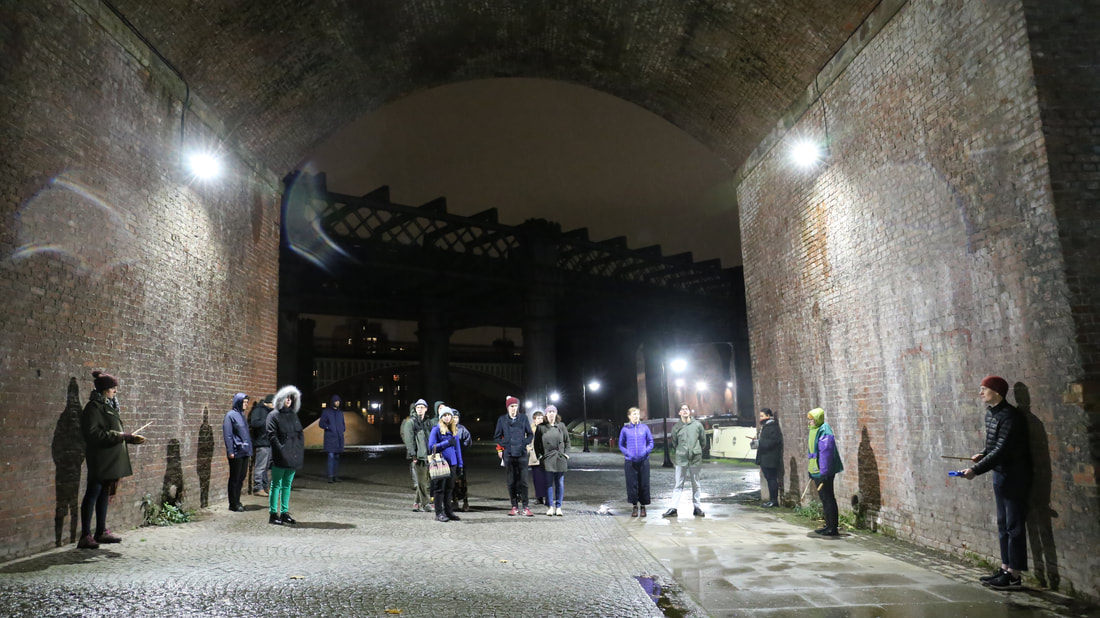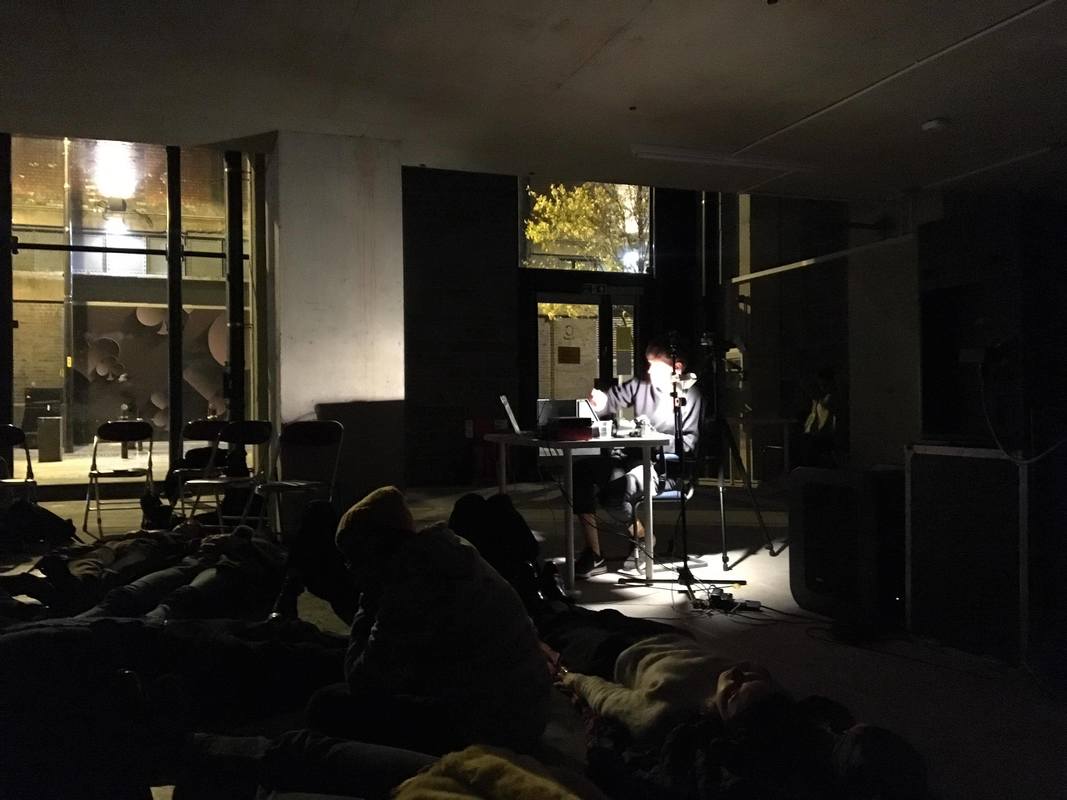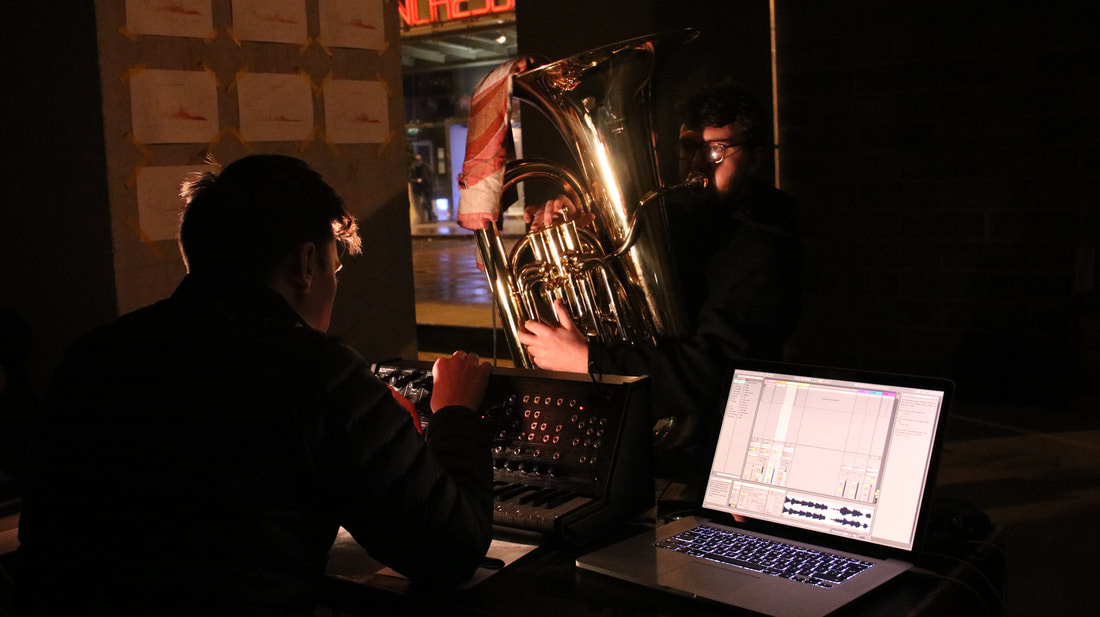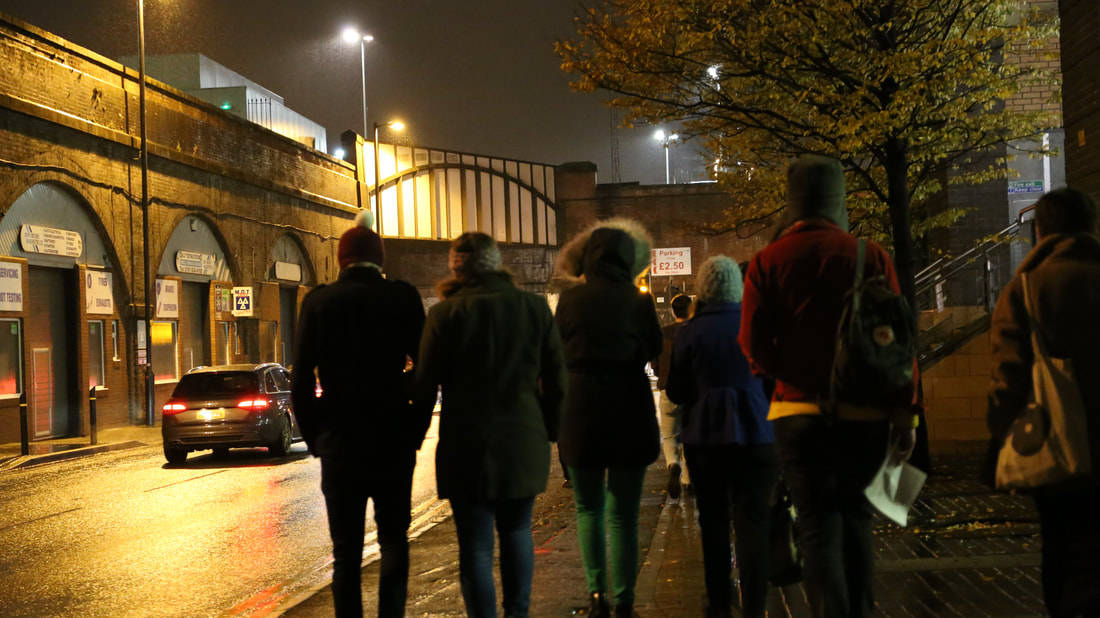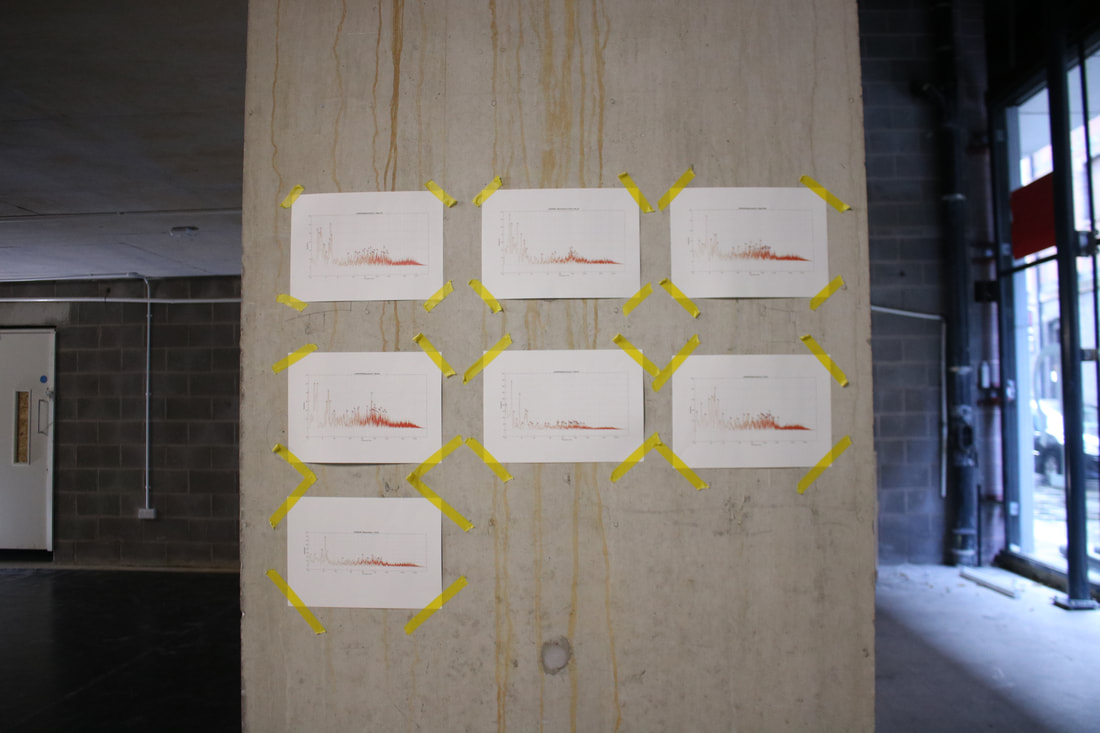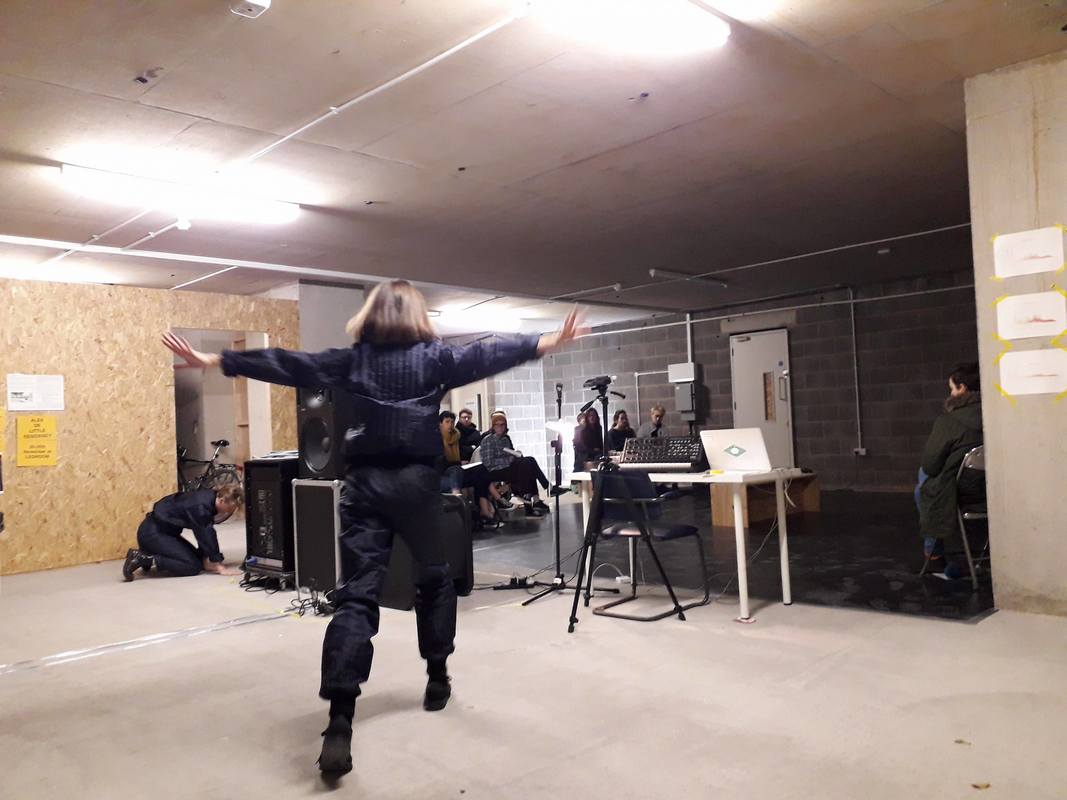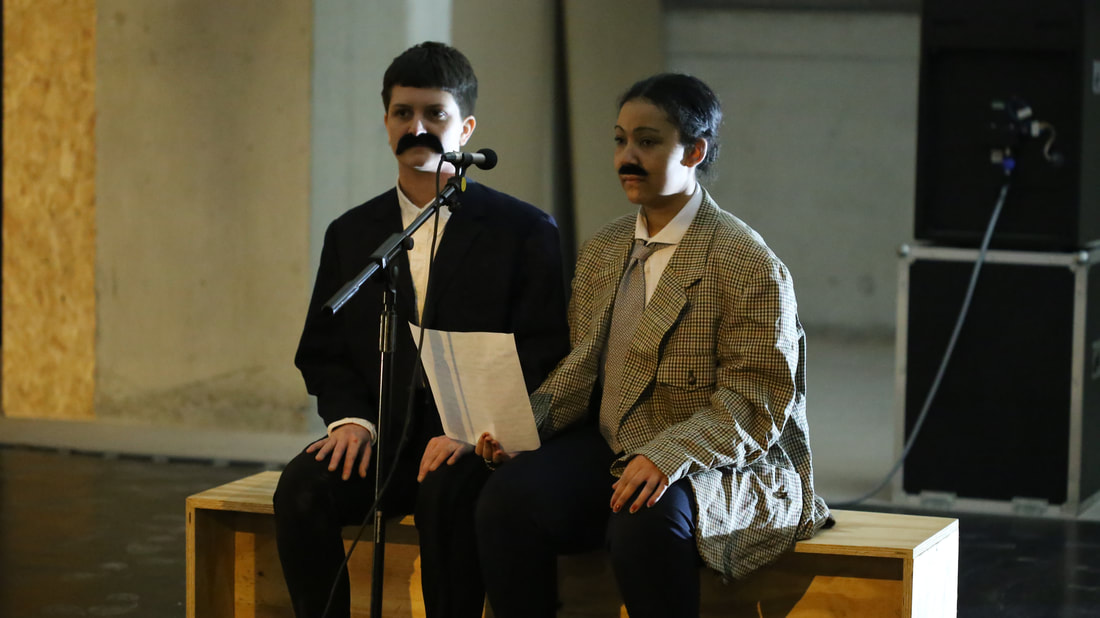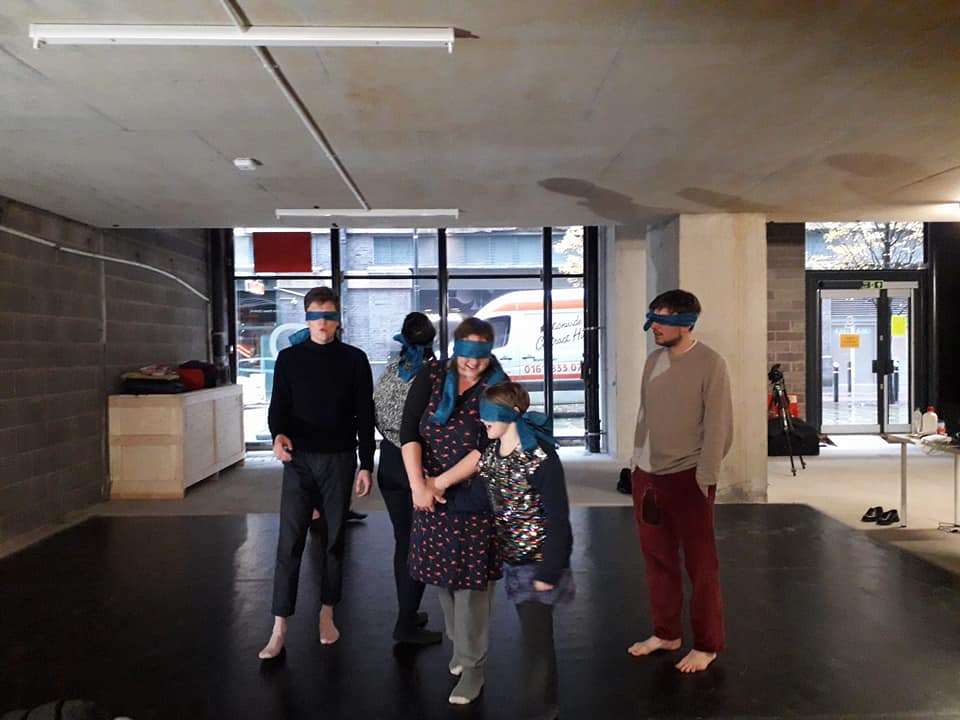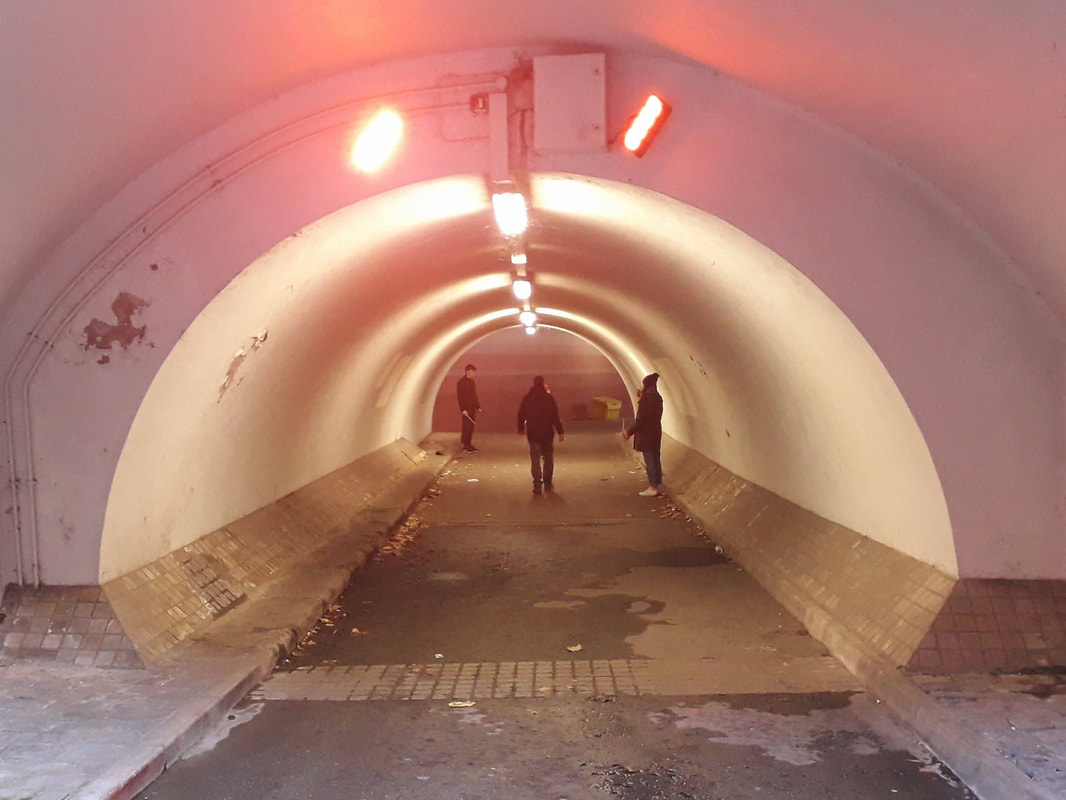Alex De Little - Reflections on 'LISTENING TO ARCHITECTURE':
"During this residency, my aim was to create a range of situations in which the LEGROOM space as well as other locations around Manchester were actively listened to by audiences: A range of workshops and pieces used the language of the physical properties of sound to frame (and reframe) space through performative games whose instructions are always determined by listening to the acoustic response(s) of the space.
Through this practice, listening becomes the method through which audiences and participants begin to know and engage with, space.
"During this residency, my aim was to create a range of situations in which the LEGROOM space as well as other locations around Manchester were actively listened to by audiences: A range of workshops and pieces used the language of the physical properties of sound to frame (and reframe) space through performative games whose instructions are always determined by listening to the acoustic response(s) of the space.
Through this practice, listening becomes the method through which audiences and participants begin to know and engage with, space.
The pieces and workshops that I created variously explored different types of movement and sound-creation in relation to this endeavour. The works used two broad approaches to ‘framing’ space. First, space as frequency, and second, space as time. The first approach aims to create understandings of spaces through exciting and listening to their resonant frequencies. The second creates understandings of spaces through the creation of sonic impulses whose resulting acoustic responses determine the rules of games and pieces – echo, reverb, reflection.
The endeavour of creating embodied knowledge of space through listening is the central aim of my PhD research, and the residency gave me a fertile ground to test ideas and situations with different groups of people in a variety of spaces. As well as performing the existing work Resonant Topologies: Listening-led Movement, I was able to develop two new pieces of work which will be key to the PhD project. The first, Spatial Drone is a live synthesizer performance which excites the strongest resonant frequencies of a given space. This is an improvisation which aims to subject a stationary audience to a range of body-listening experiences by putting the room into a range of contrasting resonant vibratory states. During this experience, the audience becomes explicitly bound to the space through vibration. The audience both hears and feels the materiality of the space. This piece was developed as both a solo performance, and as a collaborative performance with the Tuba player James Seabrook from the Royal Northern College of Music.
The second piece of work developed during the residency After Vespers: Architectural Sound Walk < video here > is a realisation of a series of games which aim to connect performer-participants with the architectural space that they occupy through impulses created from hand-held percussion instruments. In collaboration with a group of local artists who volunteered as percussionists, I worked these games into a single performance which spanned multiple architectural sites. An audience was lead round a series of architectural sites in central Manchester, which were sonically activated in various ways by a group of percussionists. The audience hear the spaces through which they are lead framed and reframed in relation to sounds that are emitted and patterns of movement which take place. This performance was created in a participatory workshop on 24 November with David Birchall, Giorgos Stenos, Amy Lawrence, Chloé Loric, and Nicole Pior.
I asked artist, technologist and collaborator Stuart Mellor to compose a piece, based on an acoustic analysis of LEGROOM which we conducted together at the beginning of the week. This acoustic analysis also formed the foundation of the performance of resonant topologies with Tora Hed and Hannah Buckley and was crucial to the development of spatial drone.
The first of my two public events Resonance, Tactility and Movement explored how we can experience space through resonance in two key ways; first, Resonant Topologies: Listening-led Movement allowed dancers and the audience to explore through movement the topologies of loud and null spots created by standing waves. Second, a performance of Spatial Drone subjected the audience to a consideration of the stationary affect of resonance on the body.
The second public event Space as Time, Space as Frequency, was the end of residency showing. The programme aimed to convey sonic understandings of the LEGROOM space and other spaces around Manchester through time and through frequency; resonance and impulse. The first performance Alvin Lucier’s I am Sitting in a Room, acted as a ‘jumping-off point’ to contextualise the event. Following this, the audience were taken on the After Vespers: Architectural Soundwalk, a walking performance which acted to excite a number of architectural sites using impulses created by a group of percussionists. The evening concluded with two resonant evocations of the LEGROOM space: Stuart Mellor’s Partial Decay, followed by Spatial Drone 2 featuring Tuba player James Seabrook from the Royal Northern College of Music.
As a practice researcher I find that these experiences of doing are as important, if not more important than the period of critical reflection and the genesis of ideas. Perhaps the most valuable aspect of this residency was the ability to bring others into the research. As the practice is subject-focussed, it cannot exist without the participation of others. Working with curators, performers, other artists and audience members gave me a range of perspectives on my practice and the way that it can be received and understood. This led me to the belief that the most effective way to work is often to keep an idea in its simplest for until one is able to take it into a space where that idea can be explored by people, and then to develop the idea on the basis of this engagement.
I also realise that almost every piece of practice that I either have made or want to make exists simultaneously at every point on a spectrum between the simplest workshop exercise and a rehearsed performance or polished installation. Often ideas start in a basic workshop setting and are scaled up according to both the idea and the opportunities which exist to develop it. One thing that isn’t always considered in the institution is that it’s important to develop work in the world in dialogue with the world.
I also realise that almost every piece of practice that I either have made or want to make exists simultaneously at every point on a spectrum between the simplest workshop exercise and a rehearsed performance or polished installation. Often ideas start in a basic workshop setting and are scaled up according to both the idea and the opportunities which exist to develop it. One thing that isn’t always considered in the institution is that it’s important to develop work in the world in dialogue with the world.
The reception of the work was generally positive. The critical element for me was that people engaged with the practice on some level and through this engagement interacted with space through listening. As I was able to work with participants on different levels, I was able to ensure that this would happen. With respect to the performers, they have to engage with space through sound in order to engage with the practice. Therefore, talking to the performers gives a nuanced understanding of what my practice is doing to them in terms of understanding space through sound.
This understanding is always subjective and completely dependent on the mode of enquiry of the practice i.e. whether a performer is exploring a space through impulse or resonance and what the means of exploration is. From an audience perspective it is difficult to say as they don’t give as many signs to what their engagement is. In pieces like Spatial Drone where the audience is lying down, it is possible to get a sense of the way that they engage with the work short of talking to them as the sound is happening to them, whereas in the architectural sound walk and in resonant topologies the audiences’ movements demonstrate their engagement with the spatiality of the sounds. The reason that I wanted to work in the public sphere is that I conceive of a kind of third audience to this practice which is the general public. I’m interested in the idea that people can chance upon a piece of practice which engages them with the space that they currently occupy through sound with no prior preparation and without any sense of event or performance.
This residency was made possible with in-kind support from LEGROOM and the University of Leeds."
Audience reaction: "It was the best thing nearly ever!" Ellie, 8 - about the workshop For Someone Who Has Never Performed A Resonance
PUBLIC EVENTS / WORKSHOPS PROGRAMME:
Wednesday 22/11 Performances 8-9.30PM: Resonance, Tactility and Movement
Resonant Topologies: Listening-Led Movement - a collaboration with dancers Hannah Buckley and Tora Hed, exploring the physical shapes of standing sine waves through choreography.
Spatial Drone - live analog synth improvisation exploring the resonant properties of LEGROOM; deep listening - body listening.
venue: LEGROOM
Friday 24/11 Workshop 5-7pm:
Listening to Manchester - Spatio-Rhythmic listening workshop - participatory workshop exploring the architecture of Manchester through listening to echoes. Open to all abilities.
Venue: secret location, meet at LEGROOM. Free / donations welcome.
Sunday 26/11 - EVENT/WORKSHOPS throughout the day culminating in an ‘end of residency’ sharing -
12-1.30PM: WORKSHOP: For somebody who has never performed a resonance - Participatory workshop which explores using singing to make architecture 'speak'. Open to all abilities.
4-6.30PM: Space as Time, Space as Frequency - END OF RESIDENCY SHARING - Meet @ LEGROOM - £5 (Donation)
Alex shares his interactions throughout the week through an event co-curated with LEGROOM, featuring:
Alvin Lucier - I am sitting in a room
After Vespers - Architectural Sound Walk / Spatio-Rhythmic listening - A performance of short pieces which explore the architecture of central Manchester through rhythm, featuring local artists David Birchall, Giorgos Stenos, Amy Lawrence, Chloé Loric, and Nicole Pior.
Stuart Mellor - Partial Decay
Alex De Little with James Seabrook - Spatial Drone 2
This understanding is always subjective and completely dependent on the mode of enquiry of the practice i.e. whether a performer is exploring a space through impulse or resonance and what the means of exploration is. From an audience perspective it is difficult to say as they don’t give as many signs to what their engagement is. In pieces like Spatial Drone where the audience is lying down, it is possible to get a sense of the way that they engage with the work short of talking to them as the sound is happening to them, whereas in the architectural sound walk and in resonant topologies the audiences’ movements demonstrate their engagement with the spatiality of the sounds. The reason that I wanted to work in the public sphere is that I conceive of a kind of third audience to this practice which is the general public. I’m interested in the idea that people can chance upon a piece of practice which engages them with the space that they currently occupy through sound with no prior preparation and without any sense of event or performance.
This residency was made possible with in-kind support from LEGROOM and the University of Leeds."
Audience reaction: "It was the best thing nearly ever!" Ellie, 8 - about the workshop For Someone Who Has Never Performed A Resonance
PUBLIC EVENTS / WORKSHOPS PROGRAMME:
Wednesday 22/11 Performances 8-9.30PM: Resonance, Tactility and Movement
Resonant Topologies: Listening-Led Movement - a collaboration with dancers Hannah Buckley and Tora Hed, exploring the physical shapes of standing sine waves through choreography.
Spatial Drone - live analog synth improvisation exploring the resonant properties of LEGROOM; deep listening - body listening.
venue: LEGROOM
Friday 24/11 Workshop 5-7pm:
Listening to Manchester - Spatio-Rhythmic listening workshop - participatory workshop exploring the architecture of Manchester through listening to echoes. Open to all abilities.
Venue: secret location, meet at LEGROOM. Free / donations welcome.
Sunday 26/11 - EVENT/WORKSHOPS throughout the day culminating in an ‘end of residency’ sharing -
12-1.30PM: WORKSHOP: For somebody who has never performed a resonance - Participatory workshop which explores using singing to make architecture 'speak'. Open to all abilities.
4-6.30PM: Space as Time, Space as Frequency - END OF RESIDENCY SHARING - Meet @ LEGROOM - £5 (Donation)
Alex shares his interactions throughout the week through an event co-curated with LEGROOM, featuring:
Alvin Lucier - I am sitting in a room
After Vespers - Architectural Sound Walk / Spatio-Rhythmic listening - A performance of short pieces which explore the architecture of central Manchester through rhythm, featuring local artists David Birchall, Giorgos Stenos, Amy Lawrence, Chloé Loric, and Nicole Pior.
Stuart Mellor - Partial Decay
Alex De Little with James Seabrook - Spatial Drone 2

